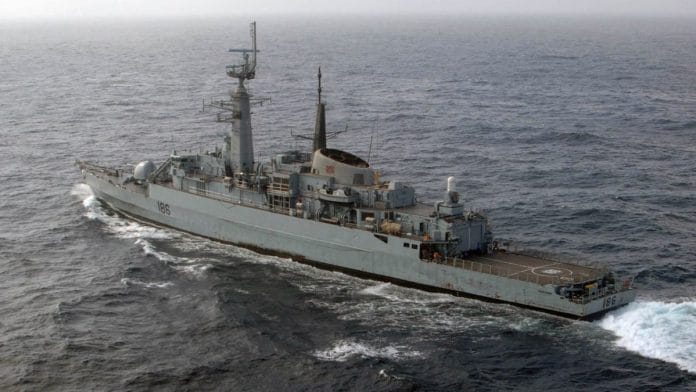New Delhi: December 4 is a dark day in Pakistan’s naval history. Way back on that day in 1971, the Indian Navy’s strike group under Operation Trident targeted the Karachi Port.
While India saw no losses, Pakistan ended up losing a minesweeper, destroyer, another ship carrying ammunition, and fuel storage tanks at the port. Another destroyer was also damaged and eventually scrapped.
Over five decades later, ahead of Navy Day, Indian Navy chief Admiral Dinesh Tripathi candidly acknowledged the “surprising” naval expansion of Pakistan and took a dig, saying that Islamabad was choosing “weapons over welfare”.
However, he underlined the challenges, saying that the Indian Navy was also tweaking its operational plans, considering the expansion.

Under focus is the Pakistan Navy’s ambitious plan to be 50-ship strong in the next decade. Incidentally, most ships would be modern state-of-art surface warships and submarines.
“The Pakistan Navy has cut a lot of new deals, encouraged by the People’s Liberation Army Navy (PLAN). Lots of collaborations are happening there. They are also catching up on SLBMs 9Ship launched Ballistic Missile),” Wajahat Khan, a senior fellow at the Atlantic Council, told ThePrint.
With the Pakistan Navy left behind by the other two Army services, he said, a catch-up burst was due.
“This catch-up burst has come thanks to the Chinese and some new European refits. Pakistan is finally waking up to the Indo-Pacific theatre and the WIOR (Western Indian Ocean Region),” he said.
It was in October 2020 that the then-outgoing Pakistan Navy chief Admiral Zafar Mahmood Abbasi detailed measures he enacted to modernise the Navy. He then spoke about expanding the Navy to more than 50 warships, more than doubling major surface combatants to 20 and plans for six additional large offshore patrol vessels, as reported by DefenseNews.
The former chief then also spoke about the transfer of a Chinese Yuan-class submarine to train Pakistani crews for its eight Hangor subs, the development of the hypersonic P282 ship-launched anti-ship/land-attack ballistic missile, and the replacement of the P-3C Orion patrol aircraft with 10 converted commercial jets, with the order for the first already placed, and the acquirement of the medium-altitude, long-endurance unmanned combat aerial vehicles as well as 20 indigenous gunboats, which will be commissioned by 2025.
Besides, he spoke about establishing the Naval Research and Development Institute to nurture indigenous design talent. The centre is making the Jinnah-class frigate, Hangor-class subs, UAV jammers, directed-energy weapons, underwater sonar surveillance coastal defence systems, unmanned underwater vehicles, and unmanned combat aerial vehicles.
Also read: Navy chief spells out mega nuclear attack submarine plan. Here’s what it is
Pakistan Navy modernisation kicked off in 2015
The foundation for the Pakistan Navy’s modernisation process was laid in 2015 when Pakistan signed a USD 5 billion agreement with China for procuring eight Type 039B-based Hangor II submarines.
Of the eight, the first four will be built in China, whereas the remaining will be made in Pakistan in collaboration with Beijing.
The submarine is an export variant of the Chinese Type 039A/41 attack submarine—equipped with an Air Independent Propulsion (AIP) system, besides heavyweight torpedoes and anti-ship cruising missiles.
The first of the eight submarines was delivered in April this year, with the entire contract to be executed by 2030.
Besides the Chinese weapons, the submarine will also fire the nuclear-capable Babur-3 cruise missile, with a range of over 400 kilometres.
Already, the Pakistan Navy operates two Agosta 70 (Hashmat class) and three Agosta 90B (Khalid class) submarines.
Turkey has upgraded the three Agosta 90B under a contract inked in 2016, giving the submarines a fresh lease of life and making them more potent.
Under the upgrade, sonar suites, periscopes, command and control systems, naval data distribution systems, converters, steering control systems, chilled water systems, and radar and electronic support systems have all been replaced.
China is upping Pakistan’s naval powers to keep India engaged, it is believed.
Besides the submarines, Pakistan has received the Type 054A/P frigates, built by China’s Hudong Zhonghua Shipbuilding yard in Shanghai.
Pakistan became the ship design’s first foreign customer under a 2017 deal for two Type 054A/P frigates, with two more ordered in 2018 and deliveries that began in 2021.
The Type 054A/P is a Pakistan-specific variant, equipped with the SR2410C long-range and Type 517/SUR17B air surveillance radars.
Currently, Pakistan’s four F-22P Zulfiquar-class frigates—earlier incapable of facing modern missile threats—are understood to be going through an upgrade. It was not immediately clear if China or Turkey was doing the upgrade.
In 2018, Pakistan also started receiving deliveries of the Turkish-designed Babur-class corvettes on order from Turkey.
The Pakistan Navy, in September last year, received the first of four Babur-class corvettes from ASFAT, the Turkish Ministry of Defence’s wholly-owned subsidiary.
Based on the MILGEM Ada-class corvette design for the Turkish Naval Forces Command, Babur-class platforms for the Pakistan Navy differ mainly in the combat suite equipment.
Pakistan and Turkey are also collaborating on the Jinnah-class frigate. Construction of the six planned frigates will begin after the completion of work on the Babur-class corvettes at the state-owned Karachi Shipyard and Engineering Works in Pakistan.
There are multiple other upgrade and acquisition programmes that the Pakistan Navy is pursuing. Incidentally, Pakistan has also procured offshore patrol vessels from Romania.
Pakistan has this month also carried out the test of the SMASH SLBM (P282)—an advanced ship-launched ballistic missile (SLBM) boasting a range of 350 km and anti-access/area-denial (A2/AD) capabilities.
The National Interest reported that the missile tested from a Zulfiquar-class frigate potentially includes Chinese CM-401 anti-ship technology, imparting supersonic manoeuvrability and precision targeting for sea and land threats.
(Edited by Madhurita Goswami)
Also read: How India’s 1st stealth technology created at IIT-Kanpur promises big boost to defence capabilities






